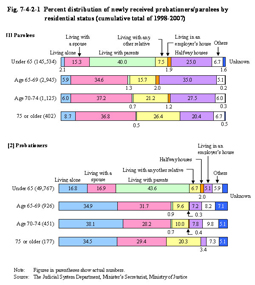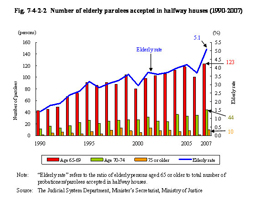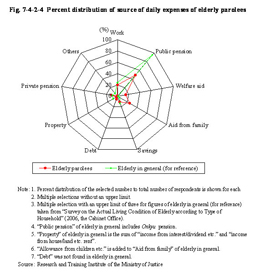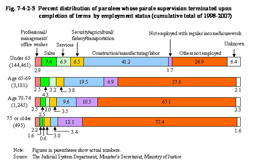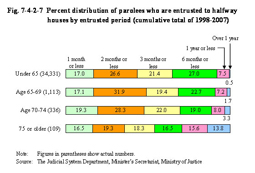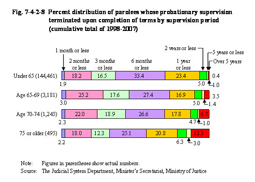| Previous Next Index Image Index Year Selection | |
|
|
2 Acceptors and other issues of elderly probationers/parolees (1) Acceptors Fig. 7-4-2-1 [1] shows the residential status of newly received prison parolees in 1998 through 2007 at the time of admission to parole supervision by age group. With elderly parolees the percent ratio of those living with their parents almost reaches zero, while that accounts for a major part with parolees under 65 years of age. Most elderly parolees returned to their spouses or other relatives, or were otherwise accepted by halfway houses or lived alone. [2] shows that, with offenders given suspension of execution of sentence with probationary supervision, the similar trend as [1] is observed with elderly, except for that the ratio of “living alone” was high and that of “halfway houses” low overall. Fig. 7-4-2-1 Percent distribution of newly received probationers/parolees by residential status (cumulative total of 1998–2007) As shown in Fig. 7-4-2-2 the number of elderly parolees accepted by halfway houses has a roughly increasing trends with the age group of “65 to 69” and “70 to 74”, and the percent ratio of those aged 65 or older (referred to as the “elderly rate” in the figure) to total number of parolees accepted by halfway houses was also increasing with 5.1% in 2007.Fig. 7-4-2-2 Number of elderly parolees accepted in halfway houses (1990–2007) (2) Problems in daily lifeAs seen in the previous sub-section quite a few elderly probationers/parolees do not have close relatives to rely on. Whether they can live self-sufficiently or not is an issue in their treatment. For this reason, problems of employment, health, and daily expenses for elderly probationers/parolees are described in this sub-section. The Research and Training Institute of the Ministry of Justice conducted opinion surveys among elderly parolees released from penal institutions during the period from August 1 to November 30, 2006, and who were received by probation offices nationwide, about one month after their release. 110 parolees responded (response rate of 55.3%), and their employment status and source of daily living expenses are given in Fig. 7-4-2-3 and Fig. 7-4-2-4, respectively. Fig. 7-4-2-3 Percent distribution of elderly parolees by employment status Fig. 7-4-2-4 Percent distribution of source of daily expenses of elderly parolees Fig. 7-4-2-3 shows that about 25% of the 110 parolees that responded were employed and about 32% had the motivation to work but were not employed yet while about 22% were unable to work due to disease. Although not shown in the figure, 46% selected “bad health” in the question concerning uncertainties and worries in their daily life. In addition, in the question concerning uncertainties and worries with health, 17% selected “no money to spend on medical treatment or prescriptions”, indicating that quite a few were uncertain and worried about their health.Next, according to Fig. 7-4-2-4, those that had selected public pensions as the source of their daily living expenses were less than half at 49.1%. For those who do not have any income from work, discussions on making welfare available to them may be needed in case they are unable to get family support as a substitute for a pension. In this survey the question was also asked whether they had any one to talk to when they were having difficulties or not, with about 19% selecting “no” as their answer. (3) Probation/parole supervision treatment of elderly As described above, those who had been admitted multiple times to penal institutions also have the problem of a relatively high repeat offence tendency. Elderly probationers/parolees especially have larger problems with adapting to society than non-elderly probationers/parolees. In addition, elderly probationers/parolees have various other problems that non-elderly probationers/parolees do not. They were in general lacking human resources such as close relatives, etc., with quite a few being unable to find jobs or with health problems in spite of their willingness to become self-sufficient, and many of them do not have any one to talk to about their problems. In order to respond to these problems, efforts are being made through probation/parole supervision treatment, for instance the category of “elderly” was established in April 2003 as part of the categorized treatment system so that proper guidance/assistance can be provided which takes into consideration the characteristics of elderly probationers/parolees. As of the end of 2007, those categorized as “elderly” included 367 persons among parolees and 527 persons among offenders given suspension of execution of sentence with probationary supervision (Source: The Rehabilitation Bureau, Ministry of Justice). Fig. 7-4-2-5 shows the percent distribution of prison parolees whose parole supervision terminated upon completion of their sentence terms between 1998 and 2007 by employment status and age group. Some were employed despite their old age while the percent ratio of “others not employed” increases with the advancement of their age. Fig. 7-4-2-5 Percent distribution of parolees whose parole supervision terminated upon completion of terms by employment status (cumulative total of 1998–2007) For elderly probationers/parolees who were unable to work due to disease, etc. it will be necessary to understand the type of support, etc. they can receive from their families and provide assistance according to their mental/physical sickness, including in some cases making arrangements for welfare support, etc. In addition, providing them with advice on subscribing to health insurance as required and instructing them to confirm their qualification to be a recipient of a public pension and the amount of lump sum payments, etc. will be needed so that they can easily make use of these systems. For those who are healthy and able to work, employment support according to their mental/physical health conditions will be provided.(4) Elderly parolees at halfway houses Fig. 7-4-2-6 shows the percent distribution of prison parolees whose parole supervision terminated upon completion of their sentence terms between 1998 and 2007 and who were entrusted to halfway houses during supervision by area of major problem in treatment and age group. In general, the percent ratio of problems that cause difficulty in providing living guidance, such as their ability to lead social lives or their personality/characteristic behavior, becomes noticeable as they advance in age. Background factors in these include cognition/behavioral problems or difficulties, etc. due to aging. In any case, for those unable to manage their own daily lives or those having tendencies to become isolated because of problems in interpersonal relationships, etc., it will be necessary to provide detailed guidance/assistance according to their needs and ensure their understanding. In addition to these problems, even among those who were healthy both mentally and physically at the time of admittance, some develop mental/physical sicknesses during their stay or become isolated in their daily lives. Although these problems are not limited to elderly parolees, with their number increasing, it is necessary to respond to such problems in a concrete manner. Halfway houses generally work in close cooperation with regional welfare and medical institutions in order that the necessary support can be provided. In addition, some halfway houses have external counselors to listen to the worries of elderly probationers/parolees or allow them to participate in collage therapy (a type of art therapy which uses such methods of expression as cutting photographs, pictures, and letters from magazines/newspapers and pasting them on boards as psychotherapy) and work on exercises to stabilize their feelings, and those having problems, etc. with using their spare time will be allowed to pursue self-sufficient measures through participating in education on damage caused by alcohol or lectures/counseling by public consultants on social and labor insurance. These efforts are also worthwhile with elderly parolees having such problems too. Fig. 7-4-2-6 Percent distribution of parolees who are entrusted to halfway houses by area of major problem in treatment (cumulative total of 1998–2007) Fig. 7-4-2-7 shows the percent distribution of prison parolees whose parole supervision terminated upon completion of their sentence terms between 1998 and 2007 and who were entrusted to halfway houses during supervision by entrusted period and age group. The percent ratio of “over 1 year” increased with the advancement of age, but there were some differences in trends between the age group of 75 or older and other age groups in that the percent ratio of the entrusted period of over 3 months accounted for nearly 50% among the age group of 75 or older. These figures indicate that elderly parolees will be more difficult to become independent of halfway houses as they advance in age.Fig. 7-4-2-7 Percent distribution of parolees who are entrusted to halfway houses by entrusted period (cumulative total of 1998–2007) (5) Parole supervision treatment and coordination of the social circumstancesFig. 7-4-2-8 shows the prison parolees whoes parole supervision terminated upon completion of their sentence terms between 1998 and 2007 by supervision period and age group. The percent ratio with over 5 years of supervision (including life imprisonment parolees) among the elderly increases as they advance in age. However, the majority of them had a supervision period of 6 months or less. In addition, although it is not shown in the figure, reimprisoned inmates who are considered to have more difficulty in adapting to society than those imprisoned for the first time tend to have shorter supervision periods, indicating that the length of the adjustment period is not in proportion with the number of problems/issues that parolees have. This makes it difficult to respond to all these issues within the supervision period only. Environment adjustment had conventionally been made to create suitable environments for rehabilitation before the parolees were released from penal institutions in order to facilitate their smooth reintegration into society (see Part 2, Chapter 5, Section 1). The Offenders Rehabilitation Act enforced in June 1, 2008 improved that by providing that “coordination of the social circumstances” shall be implemented as required, and the matters that need to be coordinated shall be clarified and coordinated in a systematic manner. The expectation therefore is that coordination for elderly inmates is to be actively implemented, such as requesting support in receiving the necessary help from public health/welfare institutions, etc., after their release. Fig. 7-4-2-8 Percent distribution of parolees whose probationary supervision terminated upon completion of terms by supervision period (cumulative total of 1998–2007) |
